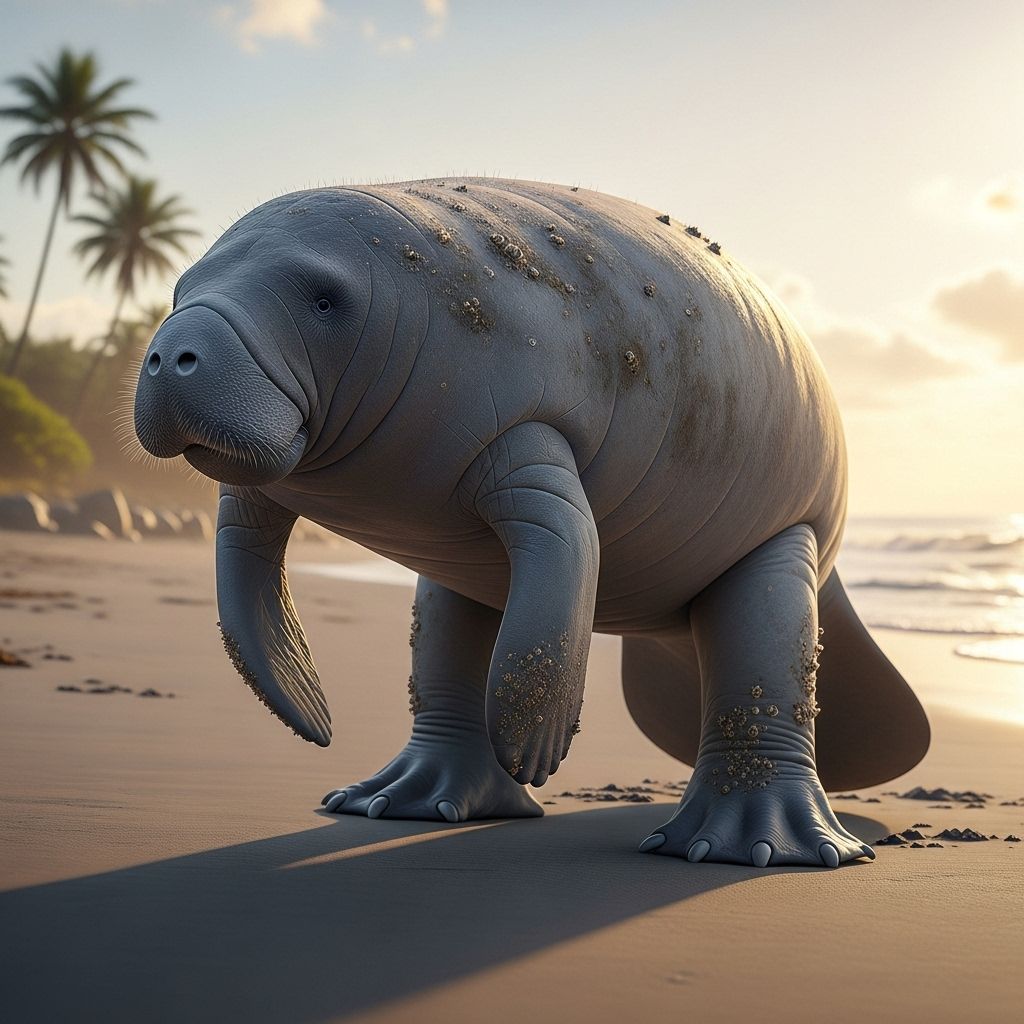Manatee Walking On Land Explained: What Science Reveals
A viral video of a manatee seemingly walking on land stuns viewers and shines light on these gentle giants’ fascinating behavior.

Image: HearthJunction Design Team
Mystery at the Water’s Edge: The Viral Manatee “Walking” Sighting
When a TikTok video surfaced showing what appeared to be a manatee calmly making its way across dry land, the footage instantly sparked fascination and confusion across the internet. Viewers from around the world asked themselves—and each other—how could a gentle, aquatic giant like the manatee, best known for floating serenely in rivers and coastal waters, be seen walking on land? This viral moment has since elevated public curiosity about manatees, their biology, and our perceptions of the animal kingdom.
Setting the Scene: How the Video Went Viral
It all began when a short, shaky TikTok clip captured a large marine mammal, unmistakably a manatee, apparently traversing a grassy patch near a Florida waterway. The video uploader gasped in the background, echoing the disbelief felt by millions who would soon watch the clip. Almost overnight, the video was reposted and referenced by countless animal lovers, wildlife organizations, and curious viewers on platforms like TikTok and YouTube.
The footage quickly prompted heated debate, spawning memes and speculative threads. In the world of online wildlife, few things generate as much buzz as the suggestion that a beloved sea creature has defied expectations and ventured onto land.
Understanding the Manatee: Gentle Giants of the Water
Manatees, also known as “sea cows,” are large, herbivorous marine mammals native to the warm coastal waters and rivers of Florida and several other tropical regions worldwide. Characterized by their rotund bodies, paddle-shaped tails, and curious whiskered faces, manatees have long inspired affection and awe. Their slow-moving, peaceful nature belies a robust adaptability to their watery environments.
- Species: There are three main species of manatees—the West Indian (including the Florida manatee), Amazonian, and West African manatees.
- Habitat: Manatees favor shallow, slow-moving rivers, estuaries, saltwater bays, and coastal areas where seagrass and other aquatic plants are abundant.
- Diet: As vegetarians, manatees spend up to eight hours a day grazing on seagrasses and vegetation.
- Unique Physiology: Despite their size—adults can weigh over 1,000 pounds—manatees are surprisingly agile underwater, capable of flips, rolls, and gentle twists.
The Science Behind the Sight: Can Manatees Actually Walk on Land?
The initial shock of the viral video gave way to scientific curiosity. Multiple marine mammal experts weighed in to clarify a crucial point: manatees cannot breathe or survive for extended periods out of water, and their bodies are not designed for terrestrial locomotion. So, what did the video truly show?
Upon closer examination, it became clear that the manatee was never truly “walking” on land. Several key points help to demystify the video:
- Shallow Flood Waters: The grassy patch shown in the clip was likely covered by a thin layer of water, invisible on camera. Manatees are known to navigate into flooded yards, parks, and even streets during high tides or after heavy rains.
- Adapted Flippers: While manatees cannot walk upright or support their weight on land, their strong, paddle-like flippers allow them to maneuver in extremely shallow water, sometimes giving the illusion of walking from a distance.
- Behavioral Curiosity: Manatees are naturally inquisitive and sometimes explore unusual surroundings if water is present, especially after storms or hurricanes.
Experts reassure that what startled viewers interpreted as “walking” was simply a manatee using its body strength to push along a submerged surface—something entirely natural and not uncommon during Florida’s rainy season.
Why the Confusion? How Animal Myths Go Viral
Animal behavior often appears strange or impossible to human eyes, especially when viral videos capture moments out of context. In the case of the “walking” manatee, several factors contributed to the widespread confusion:
- Low video angles and unclear water made it look like the animal was truly out of water.
- Lack of immediate expert commentary left space for speculation and myth-making.
- Online platforms tend to amplify the most sensational interpretation of animal behavior.
Such viral moments highlight how quickly misinformation or misinterpretation can spread, even among animal lovers. However, they also provide valuable opportunities for education and engagement with wildlife science.
The Manatee’s Relationship With Its Environment
Manatees play an essential role in the ecosystems they inhabit. Their feeding habits help maintain healthy seagrass beds and aquatic vegetation, which in turn support countless other marine species. However, manatees also face significant threats:
- Boat Collisions: One of the leading causes of manatee injuries and fatalities is collisions with watercraft. Scars from propellers are common among Florida’s manatees, leading to widespread advocacy for slow-speed zones and protective regulations.
- Habitat Loss: Coastal development, pollution, and changing water levels threaten the seagrass beds manatees depend upon for food.
- Climate Change: Warmer temperatures and increased storm activity can alter manatee habitat and lead to more frequent episodes of flooding—and odd animal encounters in unusual locations.
Despite these dangers, manatees are resilient and resourceful, as their rare forays into flooded terrestrial areas sometimes reveal.
Florida’s Manatees: Protected, Beloved, and Vulnerable
Florida, the unofficial manatee capital of the world, has worked hard to protect these iconic animals. From designated sanctuaries at places like Blue Spring State Park to widespread public education campaigns, the goal is to ensure manatees can thrive for generations to come. Local laws require modified boat propellers, posted speed limits, and robust rescue efforts for stranded or injured animals.
How to Respond to a Manatee Encounter
Should you ever encounter a manatee in an unexpected place—be it a flooded park or your own backyard—it’s important to act calmly and responsibly:
- Do not approach, touch, or attempt to move the animal.
- Keep pets and children away to avoid causing the manatee further stress.
- Contact local wildlife authorities or animal rescue organizations immediately.
- Observe from a safe distance and provide updates to responders about the animal’s location and condition.
Manatees are protected under state and federal law in Florida, and any interference—however well-intentioned—can pose risks to both the animal and the observer.
The Viral Video’s Aftermath: Inspiring Conservation and Curiosity
If there’s a silver lining to the viral manatee video, it’s the surge of interest it created in manatee conservation. Animal experts and organizations quickly moved to clarify the footage, using the moment as a launching pad for public education. Online discussions shifted from shock and speculation to learning about manatee biology, threats, and the importance of preserving aquatic habitats.
Many viewers who had never before considered the manatee’s plight were suddenly eager to learn, donate, and share accurate information. In this way, even a misunderstood viral moment can serve as a bridge between curiosity and environmental advocacy.
Fun Facts About Manatees
- Manatees have no natural predators and can live up to 60 years in the wild.
- They communicate through chirps, whistles, and squeaks, especially between mothers and calves.
- Despite their size, manatees are gentle and harmless, earning them the nickname “gentle giants.”
- They must surface for air every few minutes while active, but can rest underwater for up to 20 minutes at a time.
- Manatees’ closest living relatives are elephants and hyraxes—a surprising evolutionary connection!
Frequently Asked Questions (FAQs)
Q: Can manatees survive on land?
A: No. Manatees are fully aquatic mammals—while they can maneuver in extremely shallow water, they cannot breathe or move on dry land. The viral video likely showed a manatee swimming in a flooded area, not truly walking on land.
Q: How do manatees end up in unusual places like flooded streets or parks?
A: During periods of heavy rain or tidal flooding, waterways can overflow, allowing manatees to explore areas they wouldn’t normally access. Once the waters recede, they typically find their way back to deeper channels, but sometimes need rescue assistance.
Q: What should I do if I see a manatee in distress?
A: Contact local wildlife rescue authorities immediately. Avoid touching or approaching the animal as this can cause additional stress or harm.
Q: Are manatees endangered?
A: The West Indian manatee (including the Florida manatee) is listed as threatened under the U.S. Endangered Species Act. Their populations are slowly recovering, but they remain vulnerable due to habitat loss, boat strikes, and pollution.
Q: Why do manatees sometimes appear alongside alligators in Florida’s freshwater springs?
A: Manatees and alligators share some habitats, especially warm springs during winter. They generally coexist peacefully, as alligators are not considered a threat to adult manatees.
Table: Key Differences—Manatees vs. Other Aquatic Mammals
| Feature | Manatee | Seal | Dolphin |
|---|---|---|---|
| Primary Habitat | Rivers, estuaries, coastal waters | Oceans, sometimes freshwater | Oceans, coastal |
| Land Mobility | None (cannot support themselves) | Clumsy, but can shuffle | None |
| Diet | Herbivorous (plants) | Carnivorous (fish, squid) | Carnivorous (fish, squid) |
| Body Shape | Rounded, paddle tail | Sleek, flipper limbs | Sleek, dorsal fin, beak |
| Closest Relative | Elephant | Bears, dogs | Hippos, cows (distant) |
In Conclusion: Separating Fact from Fiction
The manatee “walking” on land was not a mutant, escapee, or supernatural event—it was a wild animal doing what it does best: adapting to the changing water levels of its home. While viral videos can sometimes mislead, they ultimately provide opportunities to deepen our appreciation and understanding of the unique creatures that share our planet.
So next time you see an extraordinary animal moment online, take a closer look. Ask questions, seek out expert explanations, and use your curiosity as a starting point for conservation. After all, as the manatee mystery reminds us, nature’s true wonders are often even more fascinating than fiction.
References
Read full bio of Anjali Sayee












